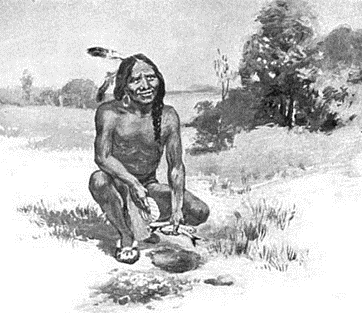Hugh was born to perfectly normal immigrant parents in late eighteenth century Pennsylvania. Finding being normal boring as hell, Hugh left home at a young age and bummed around the frontier for a decade or so, which at the time ended at the Mississippi River, doing random low paying jobs to get by. This lifestyle came to an abrupt end when at age 33 he was captured by a notorious pirate and forced to join the buccaneer's crew. Hugh made the most of this turn of events and spent two years as a pirate. He eventually returned to land, by deciding to jump off the ship and swim two miles to shore, where he was promptly captured by the Pawnee tribe, who burned his business partner alive, but spared Hugh after he gave the tribe's chief some fancy red dye. Again, just going along with it, Hugh then married a Pawnee woman and settled in with the tribe that had only recently tried to murder him.
After two years of marital bliss, Hugh decided that marriage just didn't suit him, so he left his wife and returned to civilization. He ended up joining a large group of fur trappers and traveled to the Rocky Mountains where they were attacked by another tribe called the Arikara. Soon after this attack, Hugh, who was then forty years old, got himself mauled by a grizzly bear. Convinced Hugh was going to die, the fur trappers decided to leave John Fitzgerald and a young Jim Bridger to bury him while the rest went on their way. Fitzgerald and Bridger, rightfully scared as shit of the Arikara, put the still alive Hugh in a shallow grave, took his gun and knife, and hastily left. Things did not work as planned. Hugh, despite being all torn to shit, didn't die. Instead he dragged his maggot covered corpse over 200 miles to the nearest American settlement, arriving six weeks later. During the trip he mostly lived off of roots and berries. As well, a friendly native also sewed a buffalo skin to his wounded back, though that might have just been some kind of elaborate joke.
Hugh was a little perturbed at being left to die in the middle of nowhere, and spent his time recuperating plotting intricate revenge schemes. After regaining his health, he set out to find Bridger and Fitzgerald. After several months of tracking, Hugh managed to find Bridger first, but decided to forgive him because Bridger was only 19 years old, apparently making him too young to know that abandoning people to die was the wrong thing to do. It took Hugh over a year to track down Fitzgerald. When Hugh finally found him, Fitzgerald had joined the U.S. Army. Unable to kill Fitzgerald, Hugh settled with just getting his rifle back and threatening to kill Fitzgerald if he ever left the Army.
His revenge sort of complete, Hugh took his reclaimed rifle and went back to his old job of fur trapping. His luck at this occupation continued to be poor. Hugh was attacked and wounded several more times by the natives over the next ten years. This culminated, when at age 50, Hugh's old friends the Arikara ambushed him, shot him several times, and then scalped him, finally finishing him off. Not long after, another group of fur trappers caught the Arikara responsible, and after seeing they had Hugh's beloved rifle, burned them alive. It goes without saying that the Old West in the early nineteenth century was an incredibly shitty place to live.
Image: https://commons.wikimedia.org/wiki/File:Hugh_Glass_Illustration.jpeg



